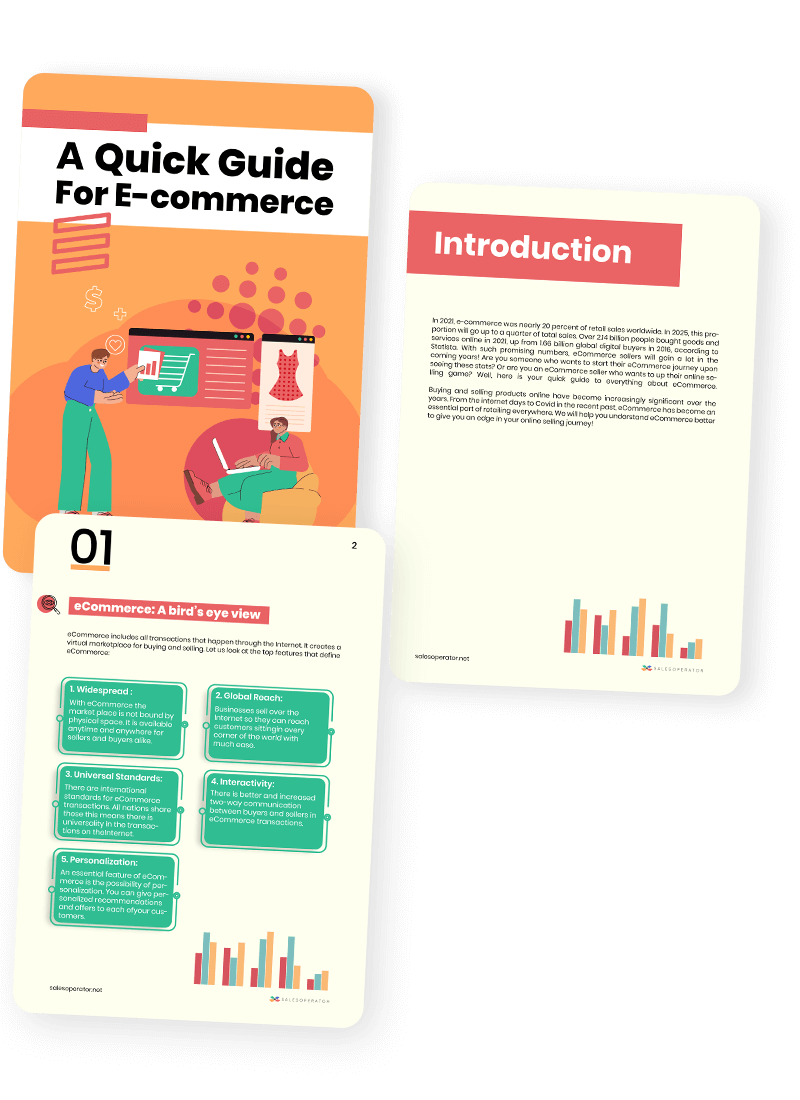In the ever-evolving landscape of e-commerce, businesses face the challenges of crafting a multi-channel pricing strategy to extract the maximum RoI. In an era of dynamic pricing, sellers will face new challenges and opportunities in selling across multiple channels, making it more critical than ever to have a well-designed pricing strategy. Sellers can improve their pricing strategies, thus profit margins, by understanding what customers value from each channel and how that impacts their purchasing decisions.
Let’s understand this with a case study.
Imagine a seller that sells sports merchandise through its website and popular online marketplaces. Initially, the seller sets similar prices on all channels, but soon realizes that the prices on their website are higher compared to the competition in the marketplace. As a result, the company sees a decrease in sales on its website and an increase in sales on the marketplace platform. Now the question is whether the seller can continue with this pricing strategy? The answer is an obvious ‘No’. This scenario highlights the importance of a well-oiled pricing strategy based on the unique characteristics of each sales channel. If your competition drops the prices, you must respond to this fast to remain competitive. By understanding the competition and customer demographics on each channel, the company could have set competitive and profitable prices on both channels, leading to increased sales and profit margins.
Challenges and Opportunities of Selling Across Multiple Channels in 2023
Monitoring competitor prices, order data, and inventory levels across all channels require constant attention and updating to keep up with changing market conditions and customer behaviour. The process can be overwhelming and prone to mistakes if not approached carefully. The actual value of a product on each channel can only be established through diligent monitoring, which can be a tedious and demanding task. Making mistakes can result in missed revenue opportunities and decreased competitiveness in the marketplace.
Benefits of Having a Well-Optimized Pricing Strategy for Multiple Channels
Multi-channel pricing strategy offers retailers a range of advantages, such as increased sales, improved efficiency, improved customer experience, and higher profits. Although coordinating a consistent pricing strategy across multiple channels can be challenging for brands, there are several practical reasons for having varying prices between channels. It allows them to dispose of excess or slow-moving inventory. A channel may provide higher margins, or a retailer may opt for more competitive retail pricing in a particular region. Additionally, multi-channel offers opportunities for A/B testing and determining which marketing and promotional efforts are more effective in different channels.
A well-optimized pricing strategy for multiple channels has several benefits, including:
- Increased Sales: By leveraging each channel’s unique characteristics, businesses can attract different customer segments and drive sales. For example, a seller may be able to sell products at a higher price on their website compared to a marketplace, where lower prices are needed to compete with other sellers.
- Increased Profit Margins: By setting competitive and profitable prices across channels, businesses can maximize their profit margins and improve their bottom line. It can be achieved by carefully considering factors such as production costs, marketing expenses, and customer demand.
- Better Price Management: A well-designed pricing strategy makes it easier for businesses to monitor and adjust prices to stay competitive and respond to changes in the market. By clearly understanding market conditions, businesses can make informed decisions about pricing and remain competitive over time.
Key Principles for Developing a Successful Multi-channel Pricing Strategy
Understanding the unique characteristics of Each Sales Channel: Before setting prices, businesses must understand the unique characteristics of each sales channel, including customer demographics, buying behaviour, and competition. Here are the key principles for multi-channel pricing:
· Setting Competitive and Profitable Prices: Businesses must set competitive and profitable prices. It means considering factors such as production costs, marketing expenses, and customer demand. It is also essential to consider the target audience for each channel and set prices that align with their expectations and purchasing power.
· Monitoring and Adjusting Prices: A well-designed pricing strategy requires ongoing monitoring and adjustment to ensure that prices remain competitive and in line with market conditions. This can be achieved through regular price audits, market analysis, and competitor research. By staying on top of changes in the market, businesses can respond quickly to price fluctuations and maintain their competitiveness.
· Get More Insights And Data: By monitoring the performance of each channel, you can make adjustments accordingly. In addition to data from external platforms, such as marketplaces, you also have access to direct sales data, which is crucial for pricing decisions. This, combined with information about your competitors’ prices, will help you make informed decisions about your pricing strategy.
Common Pitfalls to Avoid When Implementing A Multi-channel Pricing Strategy
Implementing a successful multi-channel pricing strategy can be complex and time-consuming, and there are many pitfalls to avoid.
· Undervaluing or Overvaluing Products on Different Channels
It is vital for retailers to accurately assess the value of their products on each channel and price them accordingly. It requires understanding the unique factors that influence each channel, such as operating costs, customer behavior, and market trends. By avoiding undervaluing or overvaluing products, retailers can ensure that they maximize their profits and provide a consistent customer experience across all channels.
To avoid this pitfall, businesses should take the time to research their target customers, understand the competition on each channel, and consider the cost structure of their products before setting prices. Doing so can ensure that they are pricing their products correctly on each channel and maximizing sales and profit margins.
· Failing to Monitor and Adjust Prices Regularly
Market conditions, competitor prices, and customer behaviour are constantly changing, and businesses must be prepared to adapt. Failing to do so can lead to a loss of sales and market share to more nimble competitors. Monitoring prices and making necessary adjustments ensures businesses can maximize profits and provide a consistent customer experience across all channels. Ignoring this important step can result in missed opportunities for increased revenue and decreased competitiveness in the marketplace.
To avoid this pitfall, sellers should regularly monitor their prices on each channel and adjust as needed. It can be done through pricing tools, such as dynamic pricing software, which automatically update prices based on the competition and other factors.
· Not Considering the Impact of Shipping and Other Costs on the Overall Price
Finally, businesses should be mindful of the impact that shipping and other costs have on the overall price of their products. When implementing a multi-channel pricing strategy, it’s essential to consider the shipping and handling fees, taxes, and other costs associated with each channel.
Businesses must factor in all expenses associated with each channel, including shipping and handling costs, taxes, and any additional fees, in their pricing strategy. It can help ensure that their prices are competitive and profitable and that they are not losing sales due to high shipping and handling fees.
Types of Tools For Multi-channel Pricing Management
These tools allow businesses to continuously monitor the competitive landscape, gaining an understanding of pricing trends and seasonal fluctuations. With this information, businesses can adjust their pricing strategies to stay competitive, optimizing their sales of top-selling items. Additionally, these tools provide an overview of operational insights, including comprehensive transaction data, allowing businesses to make informed decisions about their pricing strategies. It isn’t easy to take care of multiple factors.
- Price Monitoring and Adjustment Software: It is a critical tool for businesses looking to manage their pricing strategy across multiple channels effectively. The software provides real-time updates on market conditions, competitor prices, and customer demand, allowing sellers to make informed decisions about their pricing. It can benefit businesses in industries with rapidly changing market conditions, such as fashion or consumer electronics, where prices can fluctuate quickly. The software can also track price changes and provide insights into pricing trends, helping businesses make informed decisions about their pricing strategy.
- Third-Party Integration Tools For E-Commerce Platforms and Marketplaces: Integration with e-commerce platforms and marketplaces is another critical component of a successful multi-channel pricing strategy. The integration allows businesses to manage their prices in real-time across multiple channels, including their website, marketplaces like Amazon and eBay, and brick-and-mortar stores. The critical benefit of integration with e-commerce platforms and marketplaces is that it eliminates the need for manual updates, saving businesses time and reducing the risk of human error. The integration also provides a centralized view of prices across all channels, making it easier for businesses to track their pricing strategy and make informed decisions.
Another benefit of integration with e-commerce platforms and marketplaces is that it allows businesses to respond quickly to changes in the market and customer demand. For example, if a competitor lowers their prices, a business can quickly adjust its prices in real-time to remain competitive. The integration also provides access to customer data and insights from marketplaces, helping sellers better understand market conditions and customer demand.
Conclusion
Successful multi-channel pricing strategy demands a commitment to ongoing monitoring and adjustment to keep up with the changing landscape of the marketplace. However, the rewards are significant, including increased sales, enhanced customer experiences, and higher profits. By embracing the challenges and opportunities of multi-channel pricing, retailers can reap the benefits and stay ahead of the competition.




